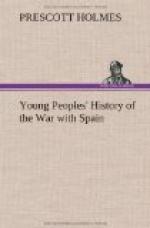The “Cape Verde” fleet, as the Spanish ships were called, troubled the Navy Department of the United States day and night. They knew that it sailed from the Cape Verde Islands in the latter part of April, but that was about all they did know regarding it. At last it was seen off the Island of Martinique and then it was lost again. It was next heard from at Curacoa, an island in the Caribbean Sea, off the north coast of Venezuela, but before the American ships could reach it, the Spanish admiral had coaled and provisioned his ships at Willemstad, the chief city on the island, and was off again to sea.
[Illustration: U.S. Battleship “Oregon.”]
There was some reason to think that the Spanish fleet might catch our great battleship Oregon, coming as fast as it could to the Eastern Coast. I must take time to tell you about the Oregon. Shortly before the war began, the Oregon was in the Pacific Ocean; but when she received a message to come to an Atlantic port, to be ready for war with Spain, she took coal at San Francisco and started—March 19th—on her long voyage. She went south through the Pacific Ocean, east through the Strait of Magellan, and then turned northward into the Atlantic Ocean. Then the closest watch was kept for the enemy; the guns were always ready, the lights were covered every night. Though Captain Clark did not know that war had really begun before that time, still he knew that there was danger. On May 24th the Oregon arrived at a port in Florida, having come 14,000 miles, through all kinds of weather, in two months’ time, without breaking anything about the ship. So the Spaniards did not catch the Oregon, but later in the year she helped to catch them.
[Illustration: Captain Charles E. Clark.]
When the Oregon arrived at. Jupiter Inlet, Florida, she was as able to fight or to run as on the day she was put into commission. When she left San Francisco she had nine hundred tons of coal on board. During the voyage she consumed almost four thousand tons. Callao was the first port where the Oregon stopped. From there she ran down the Pacific coast, and after passing through the straits sailed up the eastern coast of South America to Rio Janeiro, where she was notified by the American consul that the United States and Spain were really at war. There were now two other American warships at Rio. The gunboat Marietta had joined the Oregon near the straits, and the Buffalo, which the United States had bought from Brazil, was waiting for them at Rio. I will let Captain Clark tell you the story of the remainder of the voyage, in his own way:




